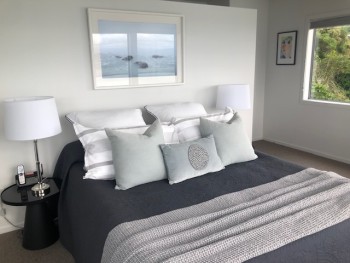Step into the average Kiwi living room of an evening, and you’ll likely find one thing – cushions on the floor; thrown, nudged or kicked there by someone trying to make their sofa comfy.
It’s a cushiony conundrum – how many is too many, or worse, too few? According to The Luxurist, there are nine chief ways to style your cushions, from the eclectic jumble to the alternating pattern to the balanced. Over at Houzz.com, Australian designer Anne Ellard claims there’s an ideal 2:2:1 ration to sofa and couch that’s key, while fellow Ocker and designer Emily Henderson reckons the style of sofa should be your guide.
But is there a perfect number, a perfect plumpness, a perfect girth of sofa cushion that we need to know to achieve that perfect seat? What’s the dish on finding the perfect cush?
"I'm a great fan of cushions, but I'm not a great fan of having lots and lots and lots of cushions all over a couch – I don’t think that adds anything" says Wellington-based interior designer and home stager Hazel Maurer, of Staged for Sale.
I'd rather have a few, good quality, interesting cushions, that have pattern and texture, so you're just adding more layers of interest.”
If she does have a rule-of thumb for how many cushions is too many, its this: Four to five cushions for a two-metre couch; no more than four for a 1.6 metre couch, and two to three for a smaller couch.
"And I don't like matchy-matchy."
Cushions are there to add texture to your decor, and to work with your curtains, throws and rugs to add interest and layers to a room.
If your style is traditional and neutral, you’ll want the cushions to reflect that, with minimal or simple patterns, and muted, natural colours. You’ll likely also want a more formal arrangement of cushions, perhaps mirroring each corner of the seat with matched sets of cushions.
In a more Boho, or maximalist room, larger, louder cushions in a variety of shapes and sizes may work better.
"It's about proportions - the proportion of the couch within the room, and the cushions on the couch,” Maurer says.
"Cushions add that other layer of softness to what you get with curtains and rugs and all the things you start layering a room with. I like putting with velvet with knitted, patterns with plain.”
But back to those cushions on the floor – Maurer always advises spending the most you can afford on your cushions, because they will stay plumper longer, and you’ll get more use out of them than you will a cheaper cushion.
"By investing in a feather insert that's 55cm by 55cm, which is a medium size, you're all of a sudden adding some luxury to the look and feel of the whole thing. That's why I don't put more than four cushions on a long couch. Because if you put all those big, plump cushions on, people are just going to end up throwing them on the floor."
It's far better, Maurer says, to have some lush, plump cush tucked into the corners that folks can imagine leaning on to watch TV, or laying their heads on for an afternoon snooze.
"A lot of people will buy four of the same cushion - two on the chairs and two on the couch - but it doesn't add that interest that the living room needs," says Maurer. "You're better to change up the sizes, or the textures."
Ideally, you shouldn’t have to remove the cushions to sit down – if there are more cushions that sofa, you’ve gone overboard, also if the cushions don’t add any support or comfort, you’ve likely picked the wrong size or shape.
"If a couch is modern, or a leather, then I quite often just put two big cushions in the corners, because small ones tend to slip and slide and never sit where they're supposed to sit. But if you put a big 60cm by 60cm, with a feather insert, they stay."
When choosing what colours, Maurer takes her cue from the art in the room, matching soft furnishings to the secondary colour of the pieces. If the images is predominantly blue-green, with tan and white accents – say, a seascape or the like – the soft furnishings will mirror the tan and white accents. But there are no hard and fast rules.
Last but not least, the essential question for all cushion lovers: to karate chop or not to karate chop? Turns out, it’s a taste thing.
"If I'm staging, I ‘knife cut’ them, at home I just plump them up," says Maurer.
"They say that it looks more professional and more elegant to knife cut them. So from a staging perspective, I always do it, and the agents like it. It looks crisp and neat and not how a family would live at all. But it can make a room look finished."

